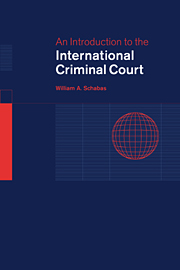Book contents
- Frontmatter
- Contents
- Preface
- List of abbreviations
- 1 Creation of the Court
- 2 Crimes prosecuted by the Court
- 3 Jurisdiction and admissibility
- 4 General principles of criminal law
- 5 Investigation and pre-trial procedure
- 6 Trial and appeal
- 7 Punishment and the rights of victims
- 8 Structure and administration of the Court
- Appendices
- Rome Statute of the International Criminal Court
- Elements of Crimes
- Rules of Procedure and Evidence
- Bibliography
- Index
Rules of Procedure and Evidence
Published online by Cambridge University Press: 05 June 2012
- Frontmatter
- Contents
- Preface
- List of abbreviations
- 1 Creation of the Court
- 2 Crimes prosecuted by the Court
- 3 Jurisdiction and admissibility
- 4 General principles of criminal law
- 5 Investigation and pre-trial procedure
- 6 Trial and appeal
- 7 Punishment and the rights of victims
- 8 Structure and administration of the Court
- Appendices
- Rome Statute of the International Criminal Court
- Elements of Crimes
- Rules of Procedure and Evidence
- Bibliography
- Index
Summary
Explanatory note
The Rules of Procedure and Evidence are an instrument for the application of the Rome Statute of the International Criminal Court, to which they are subordinate in all cases. In elaborating the Rules of Procedure and Evidence, care has been taken to avoid rephrasing and, to the extent possible, repeating the provisions of the Statute. Direct references to the Statute have been included in the Rules, where appropriate, in order to emphasize the relationship between the Rules and the Rome Statute, as provided for in article 51, in particular, paragraphs 4 and 5.
In all cases, the Rules of Procedure and Evidence should be read in conjunction with and subject to the provisions of the Statute.
The Rules of Procedure and Evidence of the International Criminal Court do not affect the procedural rules for any national court or legal system for the purpose of national proceedings.
In connection with rule 41, the Preparatory Commission considered whether the application of the rule would be facilitated by including a provision in the Regulations of the Court that at least one of the judges of the Chamber in which the case is heard knows the official language used as a working language in a given case. The Assembly of States Parties is invited to give further consideration to this issue.
- Type
- Chapter
- Information
- An Introduction to the International Criminal Court , pp. 293 - 382Publisher: Cambridge University PressPrint publication year: 2001



